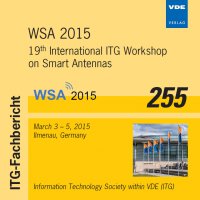Dual-Polarization Time Delay Estimation for Multipath Mitigation
Conference: WSA 2015 - 19th International ITG Workshop on Smart Antennas
03/03/2015 - 03/05/2015 at Ilmenau, Deutschland
Proceedings: WSA 2015
Pages: 6Language: englishTyp: PDF
Personal VDE Members are entitled to a 10% discount on this title
Authors:
Wendler, Friederike; Antreich, Felix (German Aerospace Center (DLR), Inst. for Communications and Navigation, 82234 Wessling, Germany)
Nossek, Josef A. (Institute for Circuit Theory & Signal Processing, Munich University of Technology (TUM), Germany)
Swindlehurst, A. Lee (Center for Pervasive Communications and Computing, University of California, Irvine CA, USA)
Abstract:
Line-of-sight (LOS) delay estimation in multipath scenarios is a central problem in global navigation satellite systems (GNSS). Deterministic channel models can be used to describe the multipath environment, but this usually requires the estimation of several nuisance parameters. In order to avoid this effort, stochastic channel models can be used. In this case the multipath statistics have to be estimated. Besides tackling the problem of multipath mitigation by exploiting the spatial diversity of LOS and multipath, polarization diversity also offers opportunities to improve the estimation performance. State-of-the-art GNSS use right-hand-circular-polarization (RHCP) transmit antennas and GNSS receivers use RHCP receive antennas. Due to multipath reflections, the signals also contain left-hand-circular-polarization (LHCP) signals, and using the LHCP antenna output, can provide an additional performance gain if the channel is modeled properly. Thus, in this paper we model and discuss exploitation of the GNSS dual-polarization channel. Using a dual-polarization model that accounts for antenna cross-talk and signal reflections intensifies the problem of computational complexity for deterministic multipath models. Therefore, we propose a correlated path (CP) model that describes the temporal correlation between the LOS and multipath signals in a stochastic way. Besides providing a significant reduction in model complexity, the CP model avoids model order estimation and a decision on the actual LOS delay from the estimation results, which is a problem if the LOS and multipath signals are highly correlated.


